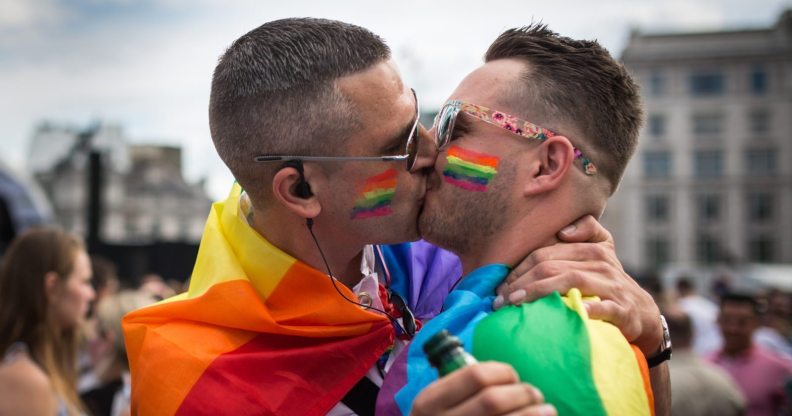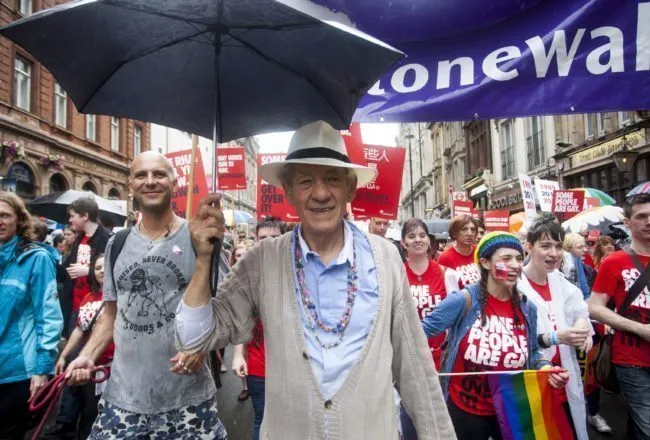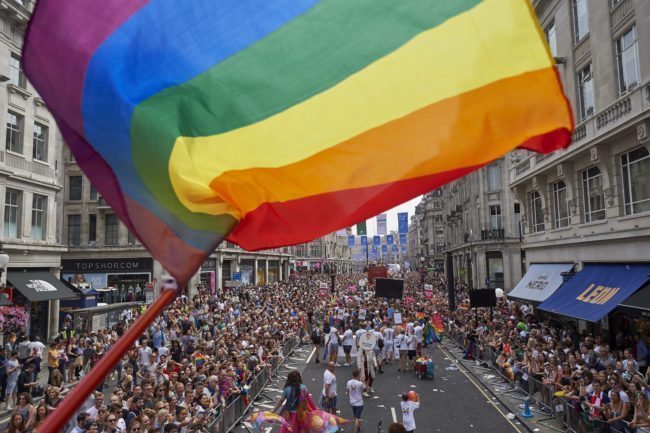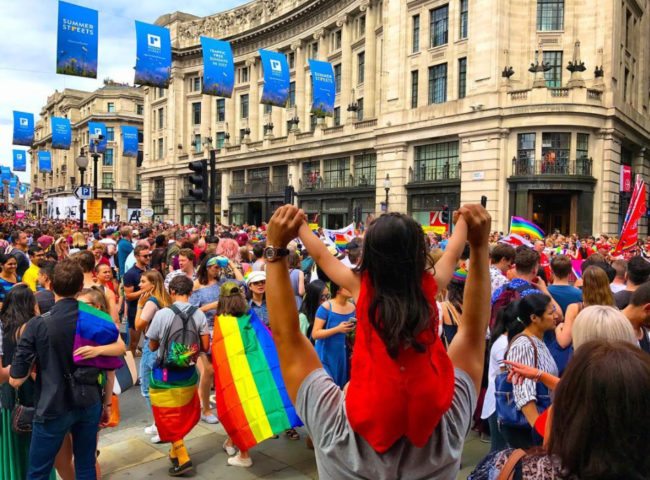Pride in London 2018: Everything you need to know about London’s annual LGBT+ celebration

A gay couple kiss in Trafalgar Square after the annual Pride in London Parade 2015. (Photo by Rob Stothard/Getty Images)
The biggest date on the British LGBT+ calendar takes place on July 7, as a huge chunk of central London closes for Pride in London 2018.
The day-long event is a celebration of inclusivity for all those within the LGBT community and its allies, who take to the streets for a variety of different events during the day.
Pride in London began in 1972 as a small event catering to 2,000 participants, but today the event rakes in more like 1 million.
What happens on the day?

(Getty)
London Pride 2018 begins with the iconic Pride Parade from midday, which sees floats representing all manner of the LGBT+ spectrum.
Businesses, charities, sports teams and the military parade through central London as they interact with the crowds on the streets, which are lined with people.
Crowds typically gather from the middle of the morning and pray for good weather as they await the Parade, which – due to its inclusivity of all the different groups of LGBT+ people – is incredibly long!
The Parade typically lasts around 4 hours, and runs alongside an entertainment schedule of events in Trafalgar Square where singers, cabaret stars and other personalities from the LGBT+ community perform.
Again, you’re advised to arrive early as access to the Square is regulated and becomes one-in-one-out later in the day when crowds thicken.
Ahead of the event, creatives can apply to perform on stage in Trafalgar Square and the finalists perform in a Pride’s Got Talent final to choose eventual winners to perform on the big day.
The cabaret act Busty & Ginger have already been chosen to perform – the idea is that Pride supports grass roots talent, who can potentially perform alongside bigger stars.
A range of other celebrities will perform on the day, alongside Pride hosts which include 1980s pop icon Sinitta.
The rest of the day’s festivities have yet to be announced, but we’ll update when we know the exact day breakdown with locations.
Around town

The annual Pride Parade in London on July 8, 2017. / AFP PHOTO / NIKLAS HALLE’N (NIKLAS HALLE’N/AFP/Getty)
Throughout the day, the area of Soho, Trafalgar Square and Piccadilly Circus are basically overtaken by the queer community, who party hard and well into the night.
And all of Soho’s gay bars and clubs get involved in the action, offering drinks deals and (hopefully) flooding out onto the sunlit streets.
Be warned though – bars and clubs are heaving as the entire community from London and further afield come into town for the celebration.
Much later, the action also moves down to Vauxhall too, where the gay clubs go on right through until the next morning.
For inspiration on where to go out partying after the parade and live performances are done, check our guide to London’s best LGBT+ bars and clubs.
PinkNews and Pride
London Mayor Sadiq Khan announced the date of London Pride 2018 at the annual PinkNews Awards in 2017, and confirmed a new five-year commitment to funding Pride in London.
Speaking at the awards Mr Khan said: “I am proud to be the first mayor ever to lead the first annual pride parade.

(Photo by taruna_seth/Instagram)
“I’m proud to have reinstated the pride reception at City hall, and proud to have published the first ever LGBT venue charter to protect and open LGBT venues in our city.
“Our aim is to safeguard its long term presence in the great city of the world.”
A brief history
The first Pride event in 1972 coincided with the anniversary of the horrific Stonewall Riots of 1969.
The event grew from a small number of men who marched through Highbury Fields in north London, gradually, and turned into the carnival-style event recognisable today.
It was from 1996 when the festival became the largest free music festival in Europe that the event demanded respect on the world stage, and today it is the seventh largest gay event in the world, and still totally free to attend.
Controversially, LGBT+ campaigners Stonewall pulled of from this year’s Pride in London over fears the event wasn’t diverse enough.
Stonewall said the annual pride event had ignored repeated “concerns about the lack of diversity and inclusion”.
Last year the organisation that runs Pride in London denied allegations from its own community advisory board that bosses refused to meet with activists from UK Black Pride.
Stonewall says it will now take a bigger role in UK Black Pride, which traditionally takes place on the same day, as it cites racism as a major ongoing problem among LGBT communities.
Some of the famous patrons of Pride in London include Sir Ian Mckellen, Sir Elton John and the tennis pro, Martina Navratilova.
Volunteers are still being accepted if you’d like to work with Pride in London 2018

